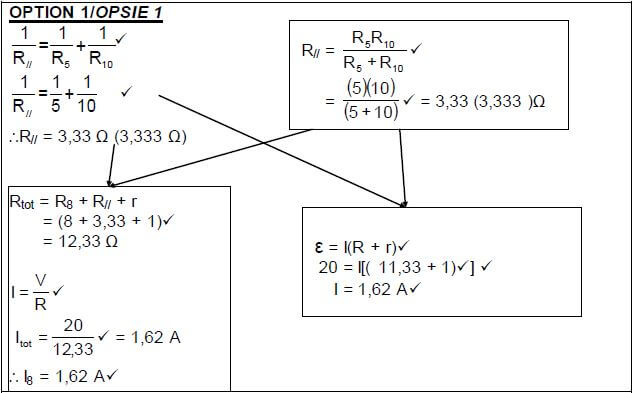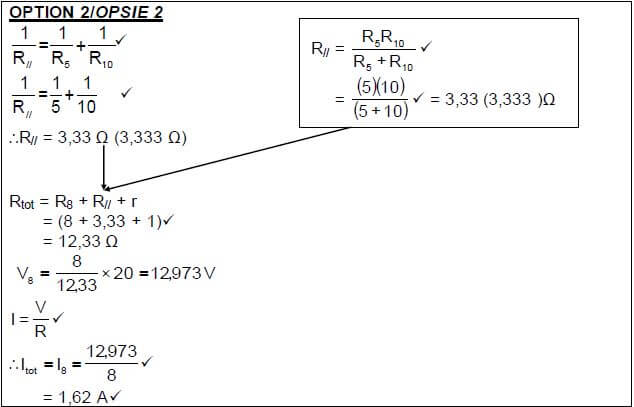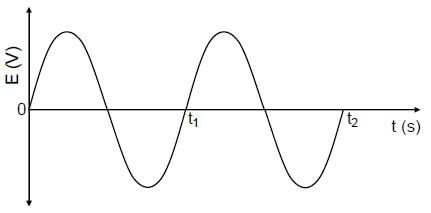PHYSICAL SCIENCES: PHYSICS PAPER 1 GRADE 12 MEMORANDUM - NSC PAST PAPERS AND MEMOS FEBRUARY/MARCH 2017
Share via Whatsapp Join our WhatsApp Group Join our Telegram GroupPHYSICAL SCIENCES: PHYSICS
PAPER 1
GRADE 12
NSC PAST PAPERS AND MEMOS
FEBRUARY/MARCH 2017
GENERAL MARKING GUIDELINES
1. CALCULATIONS
1.1 Marks will be awarded for: correct formula, correct substitution, correct answer with unit.
1.2 No marks will be awarded if an incorrect or inappropriate formula is used, even though there may be relevant symbols and applicable substitutions.
When an error is made during substitution into a correct formula, a mark will be awarded for the correct formula and for the correct substitutions, but no further marks will be given.
1.3 If no formula is given, but all substitutions are correct, a candidate will forfeit one mark.
1.4 No penalisation if zero substitutions are omitted in calculations where correct formula/principle is given correctly.
1.5 Mathematical manipulations and change of subject of appropriate formulae carry no marks, but if a candidate starts off with the correct formula and then changes the subject of the formula incorrectly, marks will be awarded for the formula and the correct substitutions. The mark for the incorrect numerical answer is forfeited.
1.6 Marks are only awarded for a formula if a calculation has been attempted, i.e. substitutions have been made or a numerical answer given.
1.7 Marks can only be allocated for substitutions when values are substituted into formulae and not when listed before a calculation starts.
1.8 All calculations, when not specified in the question, must be done to a minimum of TWO decimal places.
1.9 If a final answer to a calculation is correct, full marks will not automatically be awarded. Markers will always ensure that the correct/appropriate formula is used and that workings, including substitutions, are correct.
1.10 Questions where a series of calculations have to be made (e.g. a circuit diagram question) do not necessarily always have to follow the same order. FULL MARKS will be awarded provided it is a valid solution to the problem. However, any calculation that will not bring the candidate closer to the answer than the original data, will not count any marks.
2. UNITS
2.1 Candidates will only be penalised once for the repeated use of an incorrect unit within a question.
2.2 Units are only required in the final answer to a calculation. Eenhede word slegs in die finale antwoord op 'n vraag verlang.
2.3 Marks are only awarded for an answer, and not for a unit per se. Candidates will therefore forfeit the mark allocated for the answer in each of the following situations:
- Correct answer + wrong unit
- Wrong answer + correct unit
- Correct answer + no unit
2.4 SI units must be used except in certain cases, e.g. V∙m-1instead of N∙C-1, and cm∙s-1or km∙h-1 instead of m∙s-1 where the question warrants this.
3. GENERAL
3.1 If one answer or calculation is required, but two given by the candidate, only the first one will be marked, irrespective of which one is correct. If two answers are required, only the first two will be marked, etc.
3.2 For marking purposes, alternative symbols (s, u, t, etc.) will also be accepted.
3.3 Separate compound units with a multiplication dot, not a full stop, for example, m·s -1. For marking purposes m.s-1and m/s will also be accepted.
4. POSITIVE MARKING
Positive marking regarding calculations will be followed in the following cases:
4.1 Subquestion to subquestion: When a certain variable is incorrectly calculated in one subquestion (e.g. 3.1) and needs to be substituted into another subquestion (3.2 or 3.3), full marks are to be awarded for the subsequent subquestions
4.2 Multi-step question in a subquestion: If the candidate has to calculate, for example, current in the first step and gets it wrong due to a substitution error, the mark for the substitution and the final answer will be forfeited.
5. NEGATIVE MARKING
Normally an incorrect answer cannot be correctly motivated if based on a conceptual mistake. If the candidate is therefore required to motivate in QUESTION 3.2 the answer given to QUESTION 3.1, and 3.1 is incorrect, no marks can be awarded for QUESTION 3.2. However, if the answer for e.g. QUESTION 3.1 is based on a calculation, the motivation for the incorrect answer in QUESTION 3.2 should be considered.
MEMORANDUM
QUESTION 1
1.1 D✔✔ (2)
1.2 C✔✔ (2)
1.3 A✔✔ (2)
1.4 D✔✔ (2)
1.5 B✔✔ (2)
1.6 C✔✔ (2)
1.7 B✔✔ (2)
1.8 A✔✔ (2)
1.9 D✔✔ (2)
1.10 B✔✔ (2)
[20]
QUESTION 2
2.1 0 N/zero✔ (1)
2.2 
Accepted labels | |
w | Fg/Fw/weight/mg/gravitational force/N/19,6 N |
f | Ff riction/Ff/friction/fk |
N | FN/Fnormal/normal force |
Deduct 1 mark for any additional force. | |
Mark is given for both arrow and label | |
|
2.3.1
- Fnet = ma
fk - mgsinθ = 0
fk = mgsinθ
✔ 1 mark for any of these |
fk = (2)(9,8) sin7º ✔
fk = 2,39 N ✔ (2,389) N (3)
2.3.2 POSITIVE MARKING FROM QUESTION 2.3.1
- fk = μkN
= μkmgcos7º
✔ 1 mark for any of these
2,389 = μk(2)(9,8)cos7º ✔
µk = 0,12 ✔ (3)
2.3.3 POSITIVE MARKING FROM QUESTION 2.3.2
OPTION 1
- Fnet = ma
- fk = ma
- μkN = ma - μk(mg) = ma
✔ 1 mark for any of these
- (0,12)(2)(9,8) ✔= 2a✔
a = -1,176 m.s-2 (-1,18)
vf2 = vi2 + 2aΔx
0 = (1,5)2+ 2(-1,176)Δx✔
Δx = 0,96 m
Distance is 0,96 m✔
OPTION 2
- Wnet = ΔK
Wnet = ΔEK
Wnc = ∆K + ∆U
Wnc = ∆EK + ∆EP
μkN∆x cos θ = ½ mvf2– ½ mvi2
1 mark for any of these
NOTE: substituting into any of the above equations will lead to the following:
(0,12) (2)(9,8) ✔∆x cos 180º ✔= 0 – ½ (2)(1,5)2✔
∆x = 0,957 m✔ (5)
[15]
QUESTION 3
3.1
- (Motion of) an object in which the only force acting is the gravitational force. ✔✔
OR
(Motion of)an object which has been given an initial velocity and which follows a path entirely determined by the effects of gravitational acceleration/force. ✔✔
OR
The (motion of )an object that is projected, thrown or shot either upwards or downwards into the air and on which the only force considered/acting is gravitational. ✔✔ (2)
Note: 2 or/of 0
3.2 No ✔
- The balloon is not accelerating at the rate of 9,8 m∙s-2/moving with constant velocity/acceleration is 0 m∙s-2✔ (2)
OR
There are other forces (e.g.,friction) acting on the balloon besides gravity.✔
Net force acting on the balloon is zero
3.3
OPTION 1 Downward positive |
OPTION 2 vf = vi + aΔt ✔ |
Downward positive vf2 = vi2 + 2aΔy For both equations ✔ vf = vi + aΔt |
OPTION 3 For both equations ✔ Downward positive |
OPTION 4 |
NOTES:
|
(4)
3.4
Upward positive vf = vi + aΔt ✔ OR OR |
Downward Positive vf = vi + aΔt ✔ OR OR |
(6)
[14]
4.1 It is the product of the resultant/net force acting on an object✔ and the time the resultant/net force acts on the object. ✔ (2)
NOTE: ONLY 1 MARK FOR “CHANGE IN MOMENTUM”
4.2.1 (3)
p = mv✔ |
4.2.2
OPTION 1 ∆t for a bullet = 60✔ = 0,27 s OR -77,01 N / - 77,78 N |
OPTION 2 OR - 77,01 N / -77,78 N |
OPTION 3 OR = - 77,01 N/ -77,78 |
NOTE: ACCEPT RANGE: 77 N - 77,78 N |
(5)
4.3
POSITIVE MARKING FROM 4.2.2 77 N/77,78 N✔ to the east✔ |
(2)
[12]
QUESTION 5
5.1 (2)
The rate at which work is done/ Rate at which energy is expended. ✔✔ |
5.2.1 (3)
OPTION 1 |
OPTION 2 | -1 if either negative is omitted or Ep = mgh is used instead of W |
5.2.2 (2)
Wcounterw eight = mg∆ycosθ |
5.3
OPTION 1 -646800✔ + 512050 ✔+ Wmotor = 0 |
OPTION 2 |
OPTION 3 |
(6)
[13]
QUESTION 6
6.1.1 The Doppler effect.✔ (1)
6.1.2 Measuring the rate of blood flow
OR
Ultrasound (scanning)✔ (1)
6.1.3 (6)
FL = V ± VL FS OR FL = V FS OR FL = V FS |
6.1.4
- Increase✔ (1)
- Decrease/✔ (1)
6.2.1 The spectral lines (light) from the star are shifted towards longer wavelengths. ✔✔ (2)
6.2.2 Decrease ✔ (1)
[13]
QUESTION 7
7.1.1 Removed✔ (1)
7.1.2 (3)
n = Q Do not penalise for negative sign of charge used in calculation = 6 × 10-6 |
7.2.1 Negative ✔ (1)
7.2.2  (2)
(2)
NOTE:
Give credit to the required forces even if a triangle of forces is drawn. |
7.2.3 (3)
F = KQ1Q2 |
7.2.4 (4)
POSITIVE MARKING FROM QUESTION 7.2.3 Fx = F1,3x + F2,3x 1 mark for the addition NOTE: Fy net = 0 |
OPTION 2 = (K Q1Q3 )2 + (K Q2Q3)2 |
7.3.1 The electric field at a point is the (electrostatic) force experienced ✔per unit positive charge ✔placed at that point (2)
7.3.2 (5)
OPTION 1 100 = (9×109 )Q When the electric field strength 50 is N∙C-1 E = kQ 50 = (9×109 ) (4 x 10-9) r = 0,85 m (0,845) m✔ |
OPTION 2 E = kQ ∴ E1 = r22 ∴r = 0,85 m (0,849 m)✔ |
[21]
QUESTION 8
NEGATIVE MARKING FOR 8.1.1,8.1.2 AND 8.1.3
8.1.1
- P and Q burn with the same brightness ✔ same potential difference/same current✔ (2)
8.1.2
- P is dimmer (less bright) than R
OR - R is brighter than P✔
R is connected across the battery alone therefore the voltage (terminal pd) is the same as the emf source (energy delivered by the source). ✔
OR
The potential difference across R is twice (larger/greater than) that of P./The current through R is twice (larger/greater than) that of P.
OR
P and Q are in series and are both connected across the same battery, ✔ hence the voltage (terminal pd) is shared equally ✔(P and Q are potential dividers) Therefore R is brighter.
OR
Potential difference across P is half that across R(2)
8.1.3 T does not light up at all✔
ACCEPT
- T is dimmer (less bright) than R✔
- R is brighter than T✔
Reason- The wire acts as a short circuit. ✔
OR - The potential difference across T / current in T is zero.✔ (2)
- The wire acts as a short circuit. ✔
8.2.1 
 (6)
(6)
8.2.2
OPTION 1 |
OPTION 2 VR// = R// × Vtot |
OPTION 3 |
(4)
POSITIVE MARKING FROM 8.2.1 I5 = 10 × Itot V5 = I 5 R5 ✔ |
(4)
8.2.3
POSITIVE MARKING FROM 8.2.1 |
POSITIVE MARKING FROM 8.2.1 |
POSITIVE MARKING FROM 8.2.1 AND 8.2.2 |
OPTION 4 | |
P = V2 = 32,44 W✔ | P = I2Rtot ✔ (3) |
NOTE: Range 32,35- 32,45
[19]
QUESTION 9
9.1 Slip rings ✔ (1)
9.2  (2)
(2)
Marking criteria | |
Sine graph starts from 0. | ✔ |
Two complete waves (between t0 and t2) | ✔ |
9.3 Any TWO
- Increase the speed of rotation✔
- Increase the number of coils (turns)✔
- Use stronger magnets
ACCEPT: Increase surface area(2)
9.4
- The rms value of an AC voltage it that value of the AC voltage which will dissipate the same amount of energy as DC.
OR - The rms value of an AC voltage it that value of the AC voltage which will produce the same joule heating effect as DC. (2)
9.5 (3)
OPTION 1 1500 = Irms/w gk(240) ✔ Irms/w gk = 1500 | OPTION 2 1500 = 2402 R = 38,4 Ω = 6,25 A✔ |
[10]
QUESTION 10
10.1
- The minimum frequency of light ✔needed to emit electrons from a certain metal surface.✔
OR - The minimum frequency of light✔ below which electrons will not be emitted from the surface of a certain metal. ✔ . (2)
10.2 The speed remains unchanged. ✔ (1)
10.3 (5)
OPTION 1
|
OPTION 2
|
OPTION 3 c = f0λ0✔
|
10.4 (5)
E = Wº + EK(MAX)
Any one of the three ✔ (6,63 x 10-34)(7,8 x 1014) ✔ = (6,63 x 10-34)(6,8 x 1014) + ½mv2max |
[13]
TOTAL: 150